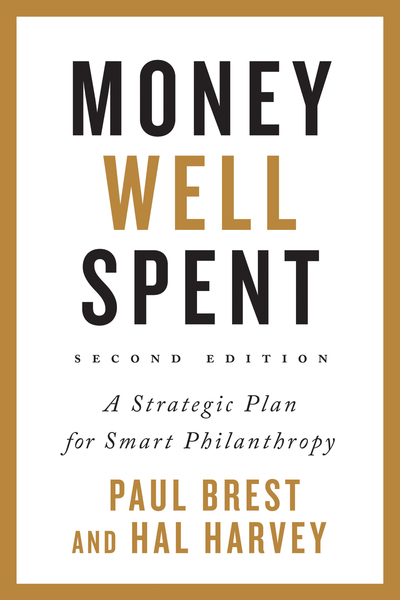
Reviewed by Michael Alberg-Seberich
How do you review the second edition of a book that has become a standard on many foundation managers’ and philanthropists’ desks? The first edition of Money Well Spent was published to praise – including in this magazine – though some reviewers also expressed a certain amount of unease. This was because the two authors really broke the ice for a new understanding of measurement and impact in the philanthropy sector. It is no surprise that their 2008 chapter ‘Impact on Steroids: Measuring the social return on your philanthropic investment’ is not to be found in the new edition in the same provocative way, but you do find a new chapter, ‘Working with others in the field’.
Overall, the tone of this book is much more conciliatory, facilitative and wise. It spends more time on collaboration efforts in philanthropy and gives more space to the importance of listening to stakeholders, people with experience of the issues in question. The book also reflects our times because it does not shy away from pointing out the dangers of political polarisation in democracies. The fact that many of the examples in this book are taken from both progressive and conservative foundations is noteworthy. Effective, strategic philanthropy does not happen in just one political arena.
The book still is a tour de force in the toolbox of strategic philanthropy – from giving vehicles to measurement. It is based on the authors’ observation: ‘You can think of most philanthropy as either responding to a problem or seizing an opportunity’. For some donors and philanthropy professionals the thoroughness of understanding societal problems presented in this book may be too much or even over-engineered. Nevertheless, the way theories of change, for instance, are introduced in this book is accessible even for the reader who believes a lot more in direct action or giving the responsibility for the best use of money back to the grantee. Brest and Harvey may not focus on these approaches and they are not at the core of their beliefs, but they still recognize them.
Though the tools and some of the approaches presented by the authors have a universal character, there is still something uniquely American about the philanthropy presented in this book. The 100-plus foundations in the US with an endowment of $1 billion is a situation that doesn’t occur anywhere else in the world and it may allow for a lot more meta-approaches. Foundations in Europe, for example, who follow the school of thought promoted in this book may not be rare but it will be much harder for them to find the choir to sing in. In addition, the book again underlines the importance of the legal frameworks for giving. Who knows – the new tax regulations alone for donations in the US may alter the complexion of US philanthropy
The second edition of Money Well Spent is as much of an instant classic on everything to know about strategic philanthropy as its predecessor. It deserves to be so. I would hope that, at least at universities, some students get the chance to compare the first to the second edition. Such an exercise may tell us a lot more about the changes in philanthropy in the last ten years. Brest and Harvey have listened to their critics, fans and other stakeholders. This book is still based on one school of thought, but it is also based on respect for the diversity of the field.
Michael Alberg-Seberich is a managing partner at Active Philanthropy and Beyond Philanthropy.
About the book
Published by: Stanford University Press
Price: $29.95
ISBN: 9781503602618
To order: http://www.sup.org/books/title/?id=28860






Comments (0)